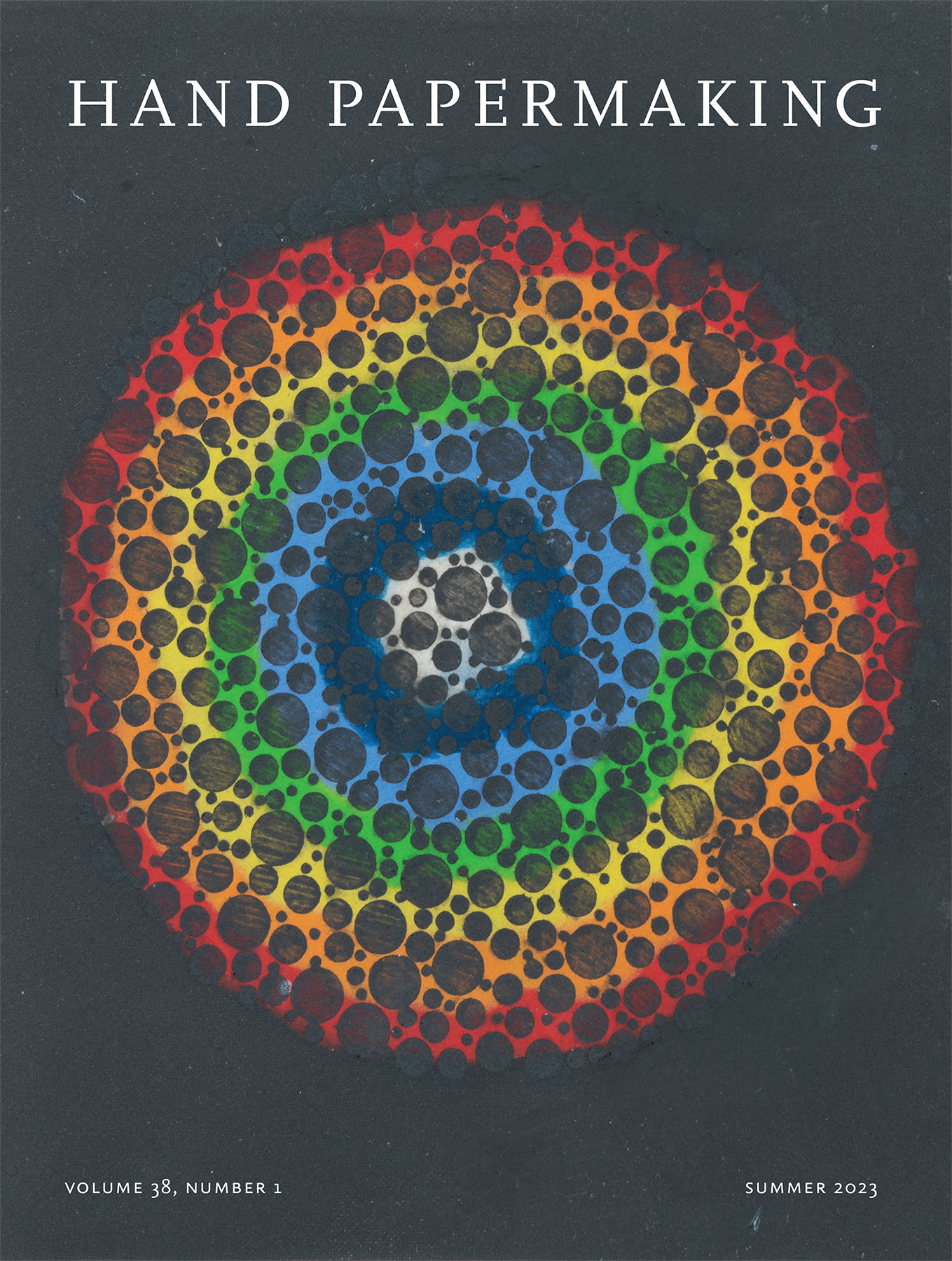Open the pages of Paper and Colour: Dyes and Dyeing around the World and you will embark on a captivating journey across the globe expressed through the experiences and research of scholars in the field of natural dyes and hand papermaking. This book contains eight essays, followed by twelve recipes, all of which explore historical dyeing traditions of non-Eurocentric cultures and adaptations made by contemporary practitioners of these techniques. Some essays discuss traditions and techniques used on cloth but the intent of the book revolves around the relationship these traditions and techniques have with paper and hand papermaking. Essays within the book range in length from 8 to 48 pages and each essay is accompanied by a range of full-color images that depict historical artifacts and techniques.
The authors of these essays are invested in the people, culture, and history of the places from which they are sharing traditional techniques. This comes across in the thoughtful personal narratives that are intertwined within the historical and technical information expressed in their writings. Many of the essays highlight culturally significant enterprises that utilize natural dyes in their papermaking processes and how these practices engage many facets of local communities. Mary Hark with Peter Boakye share insights on the striking and culturally significant Andinkra-stamped papers and textiles that are being made in Ntonso, Ghana at The Boakye Family Adinkra Workshop. Adinkra stamps are graphic symbols hand carved into calabash gourds. The symbols are “a visualization of proverbs that embody community ideals, cultural understandings, and popular sayings.”1 Hark and Boakye explain the papermaking, ink making, and stamping process, then they go on to describe how the process of the works being created are interwoven into everyday life. In “Dó Paper: Breathing New Life into an Art Form Endangered by Extinction,” author and Zó Project founder Tran Hong Nhung informs readers about the legacy of dó paper and how the integration of social enterprises and historic craft techniques may be the key to keeping knowledge of such traditional crafts from disappearing. Decorative papers that use natural dyes are highlighted throughout the book as well. Notably, in the longest essay in the book, “Uchigumo: A Choreography of Clouds,” author Nicholas Cladis takes us on a deep dive into the fascinating history of uchigumo-gami, a very specific type of decorative paper that is made in Echizen, Fukui prefecture, Japan. Uchigumo-gami is a multilayered paper with cloudlike bands of color made with naturally dyed pulp. In addition to presenting his research and experiences while living and participating within this papermaking community in Japan he also shares his own adaptations to creating cloud paper at University of Iowa’s Center for the Book.
As a papermaker and artist interested in natural-dye techniques I am eager to explore some of the recipes included in the publication. The recipes are succinct; some use site-specific materials while others discuss general methods that can be applied to materials sourced locally or ordered online. From my own investigations and online education from Maiwa School of Textiles,2 I can attest to the methods Radha Pandey outlines in her recipe, “Fermented Hemp Dyed with Lac Extract.”3
The culmination of essays and recipes in Paper and Colour leaves readers with a good overview of natural-dye processes used on paper, paper thread, and pulp. The book offers a wealth of historical and technical information provided by the authors in each essay through personal experiences, research, and useful glossaries. Also noteworthy, this publication highlights the contributions that the University of Iowa and the Center of the Book have made to further research in this field through the support of the faculty, facility use, and grants. A number of the contributing authors mention their connection to this institution.
I have no doubt that editor Radha Pandey’s excellent collection of essays and recipes will become a standard resource in the libraries of many artists and scholars. It certainly begins to fill the gap in resources for those of us interested in the historical and contemporary subject matters of natural dyes and dyeing techniques in relation to paper and pulp. It is also an engaging read for those interested in the stories that preserve cultural heritage through craft and highlight the artisans who continue to keep this knowledge alive.
___________
NOTES
1.
Mary Hark and Peter Boakye, “Adinkra-Stamped Handmade Paper in Ntonso, Ghana,” in Paper and Colour: Dyes and Dyeing around the World, edited by Radha Pandey (Ann Arbor, Michigan: The Legacy Press, 2022), 3.
2.
Maiwa is a family business located in Vancouver, British Columbia, Canada. Maiwa School of Textiles and Maiwa Natural dyes are excellent resources for education in natural-dye processes and to purchase natural-dye materials, respectively. www.maiwa.com
3.
I used a very similar method of applying tannin, mordant, then dye when I dyed abaca pulp for my edition that is included in Hand Papermaking’s limited-edition paper portfolio, The Language of Color (2023). I describe the details of the dyeing process in the portfolio’s accompanying booklet.






